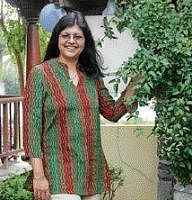The disappearance of Bangalore’s water bodies, rising temperatures and loss of green cover are favourite dinner-time conversations for most angsty Bangaloreans. Young urban ecologist Harini Nagendra just gave us more facts to substantiate our angst.
We are talking about the 38-year-old’s recent study on street trees which showed us what we always suspected, that the loss of trees was making our City warmer. Or that temperatures were significantly lower on a street with tree cover.
Harini is the Urban Ecology Coordinator at Ashoka Trust for Research in Ecology and the Environment (ATREE), Bangalore, and the Asia Research Coordinator at the Center for the Study of Institutions, Population and Environmental Change (CIPEC), Indiana University.
What drew her to urban ecology? Harini explains that after a B.Sc degree from Bangalore University, she did her M.S in Biological Sciences from the Indian Institute of Science.
Interestingly, her dissertation was about distribution of plant diversity at the landscape level. She followed it up with a Ph.D from the Centre for Ecological Sciences, Indian Institute of Science, where her dissertation was about using satellite imagery to assess species diversity within a landscape context. The studies revolved around the Western Ghats and she did her thesis under the guidance of Prof Madhav Gadgil, well-known ecologist, conservation biologist and Padmashree awardee.
But, that was only the beginning. In September 2000, she became Asia Research Coordinator at CIPEC and worked closely with Nobel Laureate Elinor Ostrom, who was a recipient of the 2009 Nobel Prize for Economic Sciences.
Harini topped this up with Society in Science: Branco Weiss research fellowship by the Swiss Federal Institute of Technology. In fact, she was among the first three international fellows to win it. Harini also won a Ramanujan Fellowship from the Department of Science and Technology for 2009-14.
What’s a typical day in the life of this urban ecologist, we ask, as she sits in a coffee shop waiting to pick up her two-and-a-half-year-old daughter after play school. “There is no typical day. Sometimes, I work from home, and there are times when I have to get involved in field work,” she says. There are other times when students come to her for guidance.
Harini is also part of a citizen’s group that is working closely with BBMP (Bruhat Bengaluru Mahanagara Palike) to save the City’s lakes. So, how has this South Bangalorean (she grew up in J P Nagar) seen her City change? Harini’s study on tree-planting patterns in Bangalore’s houses is a great mirror. It is not just an ecological study, but a socio-economic indicator as well. There are IT campuses with their manicured lawns and ornamental plants at one end of the spectrum and there are old Bangalore homes typically growing mango and tamarind trees, therefore attracting greater biodiversity, at the other end. Though these old patterns are fading out, there is still hope, says Harini. A lot of companies are now making informed choices, and shunning manicured gardens, she says.
“I live in a gated community myself, but we have taken care to ensure that the green area in front of our house is not a stereotypical manicured garden. It was way back in 2005, when we first went to live there, that I started to look for a particular mango variety and other succulent plants in and around the nurseries of Siddapura and found it difficult to get saplings. I was shown some ornamental plants instead,” she recalls.
Harini’s studies on the City’s street trees have meant that she is also scanning a bit of history. What kind of trees did Bangaloreans plant in the earlier times? Which trees have disappeared over the years? This has led her onto a different path altogether.
Harini has been working on a mystery novel set in the Bangalore of the 1890s. But, it has been difficult to finish it, though, she explains, what with juggling various roles.
How does she manage to juggle so many interests? She thanks her support system of parents, husband (a fellow IIScian who now heads a biotech firm) and in-laws who help her with the balancing act.
“I read a lot of fiction, and historical novels. I also used to play the veena, but thanks to my research, I haven’t been able to pursue it,” she says.
This Kannadiga points out that hers was a typical South Indian upbringing. “My dad worked with NAL, and my mom is a home-maker. In fact, she plays the veena rather well.” Her strong Bangalore roots show in all her work.
She hopes to conduct long-term monitoring and data collection for the next 30-40 years on issues of urban landscapes.
Such collating of data is crucial if we are to become more conscious of our cities, and Harini Nagendra certainly seems to be an important agent of change. Especially when change is for the better.
